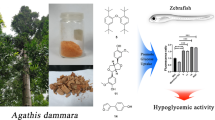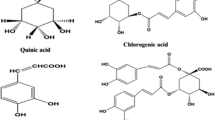Abstract
The extract of Anoectochilus formosanus showed significant activity in decreasing the levels of the cytosolic enzymes LDH, GOT, and GPT, and the result demonstrated that A. formosanus possessed prominent hepatoprotective activity against CCl4-induced hepatotoxicity. Moreover, in the results of the test using aurothioglucose-induced obese mice, the extract showed a significant antihyperliposis effect. A. formosanus grown in the wild and propagated by tissue culture contain ten compounds, including a major known component, (3R)-3-(β-d-glucopyranosyloxy)butanolide (kinsenoside; 1), and two new components, (3R)-3-(β-d-glucopyranosyloxy)-4-hydroxybutanoic acid (2) and 2-[(β-d-glucopyranosyloxy)methyl]-5-hydroxymethylfuran (3), along with the known compounds, isopropyl-β-d-glucopyranoside (4), (R)-3,4-dihydroxybutanoic acid γ-lactone (5), 4-(β-d-glucopyranosyloxy) benzyl alcohol (6), (6R,9S)-9-(β-d-glucopyranosyloxy)megastigma-4,7-dien-3-one (7), and (3R)-3-(β-d-glucopyranosyloxy)-4-hydroxybutanolide (8). Since a higher concentration of kinsenoside (1) was detected in the crude drugs A. formosanus and A. koshunensis by high-performance liquid chromatography (HPLC) analysis, we proved a simple purification system for kinsenoside (1), giving 180 mg of kinsenoside (1) from 1 g of dried samples for further pharmacological experiments. In an anti-hyperliposis assay using high-fat-diet rats, 1 significantly reduced the weights of the body and the liver, and also decreased the triglyceride level in the liver compared to those of control rats. On the other hand, the epimer of 1, (3S)-3-(β-d-glucopyranosyloxy)butanolide, goodyeroside A (9), which was isolated from the Goodyera species, had no effect for anti-hyperliposis. In aurothioglucose-induced obese mice, 1 suppressed the body and liver weight increase, significantly ameliorated the triglyceride level in the liver, and also reduced the deposition of uterine fat pads. The anti-hepatoxic activities of 9 and goodyerosides B (10) were studied on injury induced by CCl4 in primary cultured rat hepatocytes by measuring the levels of LDH, GOT, and GPT. In the CCl4-treated control group, there were marked increases in LDH, GOT, and GPT activities compared with the normal group. In contrast, these levels were suppressed in 9- and 10-treated groups. Goodyerin (11), a new typical flavone glycoside, exhibited a significant and dose-dependent sedative and anticonvulsant effect.



















Similar content being viewed by others
References
Asahishinbun (1997) Asahi encyclopedia the world of plants, vol 9. Asahishinbun Press, Tokyo pp 243–244
Jiangsu New Medical College (1977) Dictionary of the traditional Chinese medicines. Shanghai Science and Technology Press, Shanghai, pp 1334–1335
Liang WL, Chen RC, Chiang YJ, Su CH, Yang LL, Yen KY (1990) Study on Anoectochilus species. Formosan Sci 43:47–58
Kan W-S (1986) Pharmaceutical botany. National Research Institute of Chinese Medicine, Taipei, Taiwan, p 647
Zheng C, Huang Y-Z, Ji L-F (1996) Pharmacognostical studies on Jin Xian Lian. Zhongcaoyao 27:169–172
Lin CC, Namba T (1981) Pharmacognostical studies on the crude drugs of Orchidaceae from Taiwan (VI). Shoyakugaku Zasshi 35:262–271
Lin CC, Namba T (1981) Pharmacognostical studies on the crude drugs of Orchidaceae from Taiwan (VII). Shoyakugaku Zasshi 35:272–286
Du X-M, Yoshizawa T, Shoyama Y (1998) Butanoic acid glucoside composition of whole body and in vitro plants of Anoectochilus formosanus. Phytochemistry 49:1925–1928
Du X-M, Sun N-Y, Shoyama Y (2000) Flavonoids from Googyer schlechtendaliana. Phytochemistry 53:997–1000
Du X-M, Sun N-Y, Chen Y, Irino N, Shoyama Y (2000) Hepatoprotective aliphatic glycosides from three Googyera species. Biol Pharm Bull 23:731–734
Murashige T, Skoog F (1962) A revised medium for rapid growth and bioassays with tobacco tissue cultures. Physiol Plant 15:473–497
Niiho Y, Yamazaki T, Hosono T, Nakajima Y, Ishizaki M, Kurashige T (1993) Pharmacological studies on small peptide fraction from soybean. The effects of small peptide fraction derived from soybean on fatigue, obesity and glycemia in mice. Yakugaku Zasshi 113:334–342
Raucy JL, Kraner JC, Lasker J (1993) Bioactivation of halogenated hydrocarbons by cytochrome P4502E1. Crit Rev Toxicol 23:1–20
Faroon O, De Rosa CT, Smith L (1994) Carbon tetrachloride-health effects, toxicokinetics, human exposure and environmental fate. Toxic Ind Health 10:4–20
Clawson GA (1989) Mechanisms of carbon tetrachloride hepatotoxity. Pathol Immunopathol Res 8:104–112
Brecher G, Waxler SH (1949) Obesity in albino mice due to single injections of goldthioglucose. Proc Soc Exp Biol Med 70:499–501
Brecher G, Laquer GL, Cronkite EP, Edelman PM, Schwartz IL (1965) The brain lesion of goldthioglucose obesity. J Exp Med 121:395–401
Rizack MA (1961) An adrenaline-sensitive lipolytic activity in adipose tissue. J Biol Chem 236:657–662
Liu S-Y, Chang T-W, Wang J-Y, Chang A-H, Wang S-C (1998) Study on the varietal characters and acute toxicity of Anoectochilus spp. J Agric Res China 47:242–258
Kannel WB, Castelli W, Gordon T (1971) Serum cholesterol, lipoproteins, and the risk of coronary heart disease. Ann Int Med 74:1–12
Goldbourt V, Holtzman E, Neufeld NN (1985) Total and high density lipoprotein cholesterol in the serum and risk of mortality: evidence of threshold effect. Br Med J 290:1239–1243
Nomura H, Kashiwagi S, Hayashi J, Kajiyama W, Tani S, Goto M (1988) Prevalence of fatty liver in a general population of Okinawa. Jpn J Med 27:142–149
Liu SY, Tsay HS, Huang HC, Hu MF, Yeh CC (1987) Comparison on growth characteristics and nutrient composition between plants of Anoectochilus species from mass vegetative propagation by tissue culture techniques. J Agr Res China 36:357–341
Du X-M, Sun N-Y, Yoshizawa T (1997) A higher yielding isolation method for kinsenoside. Japan Kokai Tokkyo Koho 11–92492
Ito A, Yasumoto K, Kasai R, Yamasaki K (1994) A sterol with an unusual side chain from Anoectochilus koshunesis. Phytochemistry 36:1465–1467
Taguchi H, Yoshioka I, Yamasaki K, Kim L (1981) Studies on the constituents of Gastrodia elata. Chem Pharm Bull 29:55–62
Pabst A, Barron D, Sémon E, Schreier P (1992) Two diastereomeric 3-oxo-α-ionol β-glucosides from raspberry fruit. Phytochemistry 31:1649–1652
Yoshikawa M, Shimada H, Saka M, Yoshizumi S (1997) Absolute stereostructures of corchoionosides A, B and C, histamine release inhibitors from the leaves of Viethamese Corchorus olitorius. Chem Pharm Bull 45:464–469
Du X-M, Kohinata K, Kawasaki T, Guo Y-T, Miyahara K (1998) Components of the ether-insoluble resin glycoside-like fraction from Cuscuta chinensis. Phytochemistry 48:843–850
Cao W, Li Y, Zhu D (1999) Phenolic glucosides and a gamma-lactone glucoside from the sprouts of Crocus sativus. Planta Med 65:425–427
Hara S, Okabe H, Mihashi K (1987) Gas-liquid chromatographic separation of aldose enantiomers as trimethylsilyl ethers of methyl 2-(polyhydroxyalkyl)-thiazolidine-4-(R)-carboxylates. Chem Pharm Bull 35:501–505
Brecher G, Waxler SH (1949) Obesity in albino mice duo to single injections of goldthioglucose. Proc Soc Exp Biol Med 70:498–501
Brobeck JR (1946) Mechanism of the development of obesity in animals with hypothalamic lesions. Physiol Rev 26:541–559
Han PW, Liu AC (1966) Obesity and impaired growth of rats. Am J Physiol 211:229–231
Meldrum BS, Chapman AG (1986) Benzodiazepine receptors and their relationship to the treatment of epilepsy. Epilepsia 27(Suppl)S3–S13
Macdonald RL (1988) Anticonvulsant drug actions on neurons in cell culture. J Neural Trans 72:173–183
Delgado-Escueta AV, Ward AA, Woodbury DM, Porter R (1986) New wave of research in the epilepsies in advances in neurology. Adv Neurol 4:3–55
Harborne JB (1994) The flavonoids, advances in research since 1986. Chapman, London
Middleton E, Kandaswami C (1994) The impact of plant flavonoids on mammalian biology: implications for immunity, inflammation and cancer. In: Harbome JB (ed) The flavonoids, advances in research since 1986. Chapman, London, pp 619–645
Medina JH, Paladini AC, Wolfman C, Levi de Stein M, Calvo D, Diaz L (1990) Chrysin (5,7-di-OH-flavone), a naturally-occurring ligand for benzodiazepine receptors with anticonvulsant properties. Biochem Pharmacol 40:2227–2232
Paladini AC, Marder M, Viola H, Wolfman C, Wasowski C, Medina JH (1999) Flavonoids and the central nervous system: from forgotten factors to potent anxiolytic compounds. J Pharm Pharmacol 51:519–526
Viola H, Wasowaki C, Levi M, Wolfman C, Silveira R, Dajas F, Medina JH, Paladini AC (1995) Apigenin, a component of Matricaria recutita flowers, is a central benzodiazepine receptors-ligand with anxiolytic effects. Planta Med 61:213–216
Wolfman C, Viola H, Paladini AC, Dajas F, Medina JH (1994) Possible anxiolytic effects of chrysin, a central benzodiazepine receptor ligand isolated from Passiflora coerulea. Pharmacol Biochem Behav 47:1–4
Shoyama T, Nishioka I, Hatano K (1991) In: Bajaj YPS (ed) Biotechnology in agriculture and forestry, vol 15. Springer, Berlin, pp 58–72
Acknowledgments
The authors give thanks to the financial support from the Special Coordination Funds for Promoting Science and Technology of the Japan Society for the Promotion of Science.
Author information
Authors and Affiliations
Corresponding author
Rights and permissions
About this article
Cite this article
Du, XM., Irino, N., Furusho, N. et al. Pharmacologically active compounds in the Anoectochilus and Goodyera species. J Nat Med 62, 132–148 (2008). https://doi.org/10.1007/s11418-007-0169-0
Received:
Accepted:
Published:
Issue Date:
DOI: https://doi.org/10.1007/s11418-007-0169-0




